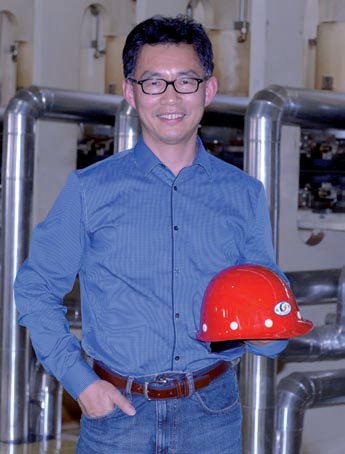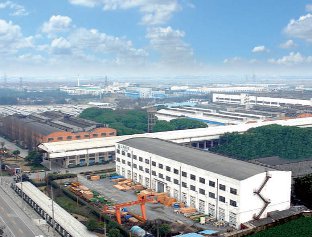Selling in China since 1995
24 July 2014Dieffenbacher of Eppingen, Germany, has been present on the Chinese market for 19 years. Here we look at the company’s track record in what has been a very fast-growing market for MDF and particleboard and, more recently, OSB
The success story began in 1995, when Dieffenbacher received its first two orders from PTP Ltd, a foreign company which was one of the first panel makers to invest in the Chinese market. The company's two factories were PTP Leshan, in Sichuan Province; and PTP Shishou, in Hubei Province.
The two MDF lines, which at the time were the largest MDF lines with a Dieffenbacher CPS press in China, started operating in 1996 and 1998.
In 2003, Guangxi Gaofeng ordered the next continuous MDF line with a CPS press, designed to handle a daily capacity of 500m³. This project was followed by a wave of follow-up orders.
Since 2002, Dieffenbacher has received orders for 43 continuous press lines in China.
Dieffenbacher says that the successes it has achieved over the years would not have been possible without a firm base in China, with the company's own personnel, who understand the culture and know the language. For this reason, the company established the Dieffenbacher Beijing Office in 1999 as a sales office, and then Dieffenbacher Machinery Service Beijing, in 2002, as a service centre to provide maintenance support, customer service within China, and a customer-oriented spare parts supply service.
In 2006, the first production site was established in Changzhou. All three companies are headed up by managing director Liu Shouhua, who joined Dieffenbacher in 1998 when the company took over the wood panel operations of Carl Schenck AG. The now 17-strong team is said to enjoy an excellent reputation among Chinese customers.
Dieffenbacher SWPM
In 2009, Dieffenbacher announced its takeover of 70% of Shanghai Wood Based Panel Machinery (SWPM). By taking this majority stake, Dieffenbacher wanted to expand its position in the Chinese market further. With experience gained from almost 300 multi-opening presses, Dieffenbacher SWPM has a market share of around 75% in this segment in China.
In addition, SWPM was the only Chinese company able to deliver complete lines. State-owned firm to market leader SWPM can look back on a long history: the company was founded as a state-owned enterprise in 1952.
Since 1962, SWPM has produced machines for the manufacture of wood based panels at its facility in the Anting industrial park in Shanghai.
In 1984, the company delivered the first MDF line with a multi-opening press in China. This was followed by the first particleboard panel system with a multiopening press seven years later.
Technological advances through to modern continuous press systems were clear to see in China as well. In 2000, for example, SWPM started developing a continuous press. Work on this project moved up a gear after the company was joined by the Kronospan Group and, with its completion, the ContiPlus was born.
After the takeover, Dieffenbacher adjusted the ContiPlus press concept to production lines with a width of 4ft, which are ideally suited to small and medium capacities. The 8ft- and 9ft-wide continuous CPS presses from the German manufacturer also cater for customers requiring larger capacities with an annual output of 200,000m³ or higher.
Chinese company, German identity With some 700 employees working on an 80,000m2 site, SWPM in Shanghai is both the newest and largest production site in the Dieffenbacher Group.
When Dieffenbacher took over the majority stake in the company in 2009, it was faced with two challenges: the former state-owned enterprise followed its own rules; and there was also a fear that the German competitor might close the production site after just a short period of time. This fear has proved to be completely unfounded, as a great deal has changed since then.
Dieffenbacher has invested heavily in the modernisation and expansion of production capacities, developed further engineering capacity, and gradually increased production quality to comply with Dieffenbacher standards.
Nevertheless, Dieffenbacher-SWPM has remained an authentic Chinese company. With a Chinese management team, highly qualified young Chinese people are being recruited in a targeted manner and - from engineering through to production - are making the ContiPlus their own. So how has Dieffenbacher managed to achieve this success?
"The secret is not to try to enforce the German 'stubborn' approach at any cost, but rather to accept and respect different mentalities and cultures," explains Heiko Heitlinger, who is responsible for global production at Dieffenbacher. "It is important for everyone to listen to one another, as you can learn a lot from others. In fact, some situations require a different approach in different countries. Global teamwork is the key to success."
Great potential for SWPM
With more than 300 multi-opening lines sold to date for MDF production in China, Dieffenbacher SWPM says it has a broad, satisfied, customer base, and a market share of around 60% for these lines, which are normally designed for an annual capacity of 80,000m³.
Today, multi-opening lines only play a minor role in new investments. In the last three years, approximately 90% of orders for lines in China were for continuous systems - and the majority of these orders were for lines with a width of 4ft. These lines have a total installed MDF capacity of five million m³/year. Disadvantages of the multi-opening lines include: Productivity losses due to cycle production; greater material losses due to longitudinal edge trimming and the sanding allowances required; and higher glue, sanding medium and energy costs.
Moreover, panels with a thickness of less than 8mm can barely be produced economically on multi-opening lines.
Nowadays, investing in a multi-opening line - whether it is 4ft or 8ft - is rarely costefficient. Thanks to more accurate spreading, and the use of a continuous press, around 38% less waste is produced from the sanding process; and 42% less from trimming. For these reasons, the leap from a multiopening line to a continuous ContiPlus system is the right investment for many customers in order to increase capacity and improve efficiency.
Various solutions are possible - from replacement of the press through to replacement of the entire production line, including wood preparation.
Compared with a conventional multiopening line, the replacement concepts achieve a saving of at least 10% on manufacturing costs with ContiPlus. The investment costs for replacing the multiopening line with a ContiPlus system can therefore be amortised within a few years.
ROI after two years
Calculating the ROI by comparing a multiopening line with ContiPlus at a capacity of 400m³/day, and for panels that have a thickness of 16mm and a density of 730kg/m³, Dieffenbacher presents the figures shown in the table.
OSB trend in China continues
When the first continuous OSB system with an 8ft-wide CPS from Dieffenbacher started up at Hubei Baoyuan Wood Industry Co Ltd in Jinmen City, Hubei Province, in 2010, no one had anticipated today's growing demand for OSB products.
The capacities were expected to be more than sufficient.
Four years later, it became clear that the opposite was true. Over the course of this year and next year, three further continuous OSB systems will start operating in China, and another in Malaysia, with the result that all continuous OSB systems currently in China are supplied by Dieffenbacher.
The first of these new systems can be found at Kangxin New Materials Science & Technology Stock Co Ltd in Hanchuan City, also in Hubei Province, and this line will be starting production with special OSB panels made from poplar.
The plywood manufacturer produces container floors made from OSB, offering an alternative to the standard plywood container floors available.
To ensure that the panels have the same tensile strength, pressure resistance and bending strength as plywood, Dieffenbacher has developed a special spreading system. The complete scope of supply includes everything from size-reduction through to the storage system. The 8.5ft x 40m CPS press will be used here.
Guizhou YuanFang Forestry Investment and Development Co Ltd, meanwhile, decided on spruce as the raw material for its OSB panels, as it is in plentiful supply in Guiang Province.
The system is designed to handle an annual capacity of 250,000m³ and is scheduled to start operating in 2015. Dieffenbacher is supplying the complete system, with an 8.5ft x 30m CPS, covering everything from strand preparation to raw board handling.
The system at Shouguang Luli Wood Co Ltd, in Shangdong Province, is also scheduled to start operating in 2015. It is designed for an annual capacity of 300,000m³ and can produce both standard OSB and special OSB panels with a smooth coating made from chips.
Here, too, Dieffenbacher is supplying the entire system, covering everything from sizereduction to the storage system. At the core of this system is an 8.5ft wide and 40m-long CPS continuous press.
The latest development, which is seeing more OSB systems being installed in China, is driven by a growing demand for high quality and extremely durable panels for furniture, flooring and heavy-duty shelves.
The rising standard of living in China is strengthening this trend in the Chinese economy, which has, until now, been very export-oriented.
The reason for this trend is ultimately the increasing prices of raw materials in China. There is virtually no demand for MDF now, because even high-quality particleboard for the furniture industry needs to be produced at lower cost.
In the construction sector, the replacement of expensive plywood panels with OSB is one sign of this development.
Dieffenbacher has also seen an increase in demand for LVL projects for producing girders and beams in China.
With experience gained from work on seven LVL systems, complete with feed station, lay-up station and microwave preheating equipment, Dieffenbacher says that its customers can be sure that it will deliver the same level of expertise and efficient machine technology as it would for OSB systems.





